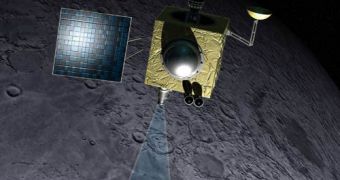The Indian Space Research Organization (ISRO) recently announced plans to design and develop a second mission to the Moon, which will see an orbiter and a rover being deployed to Earth's natural satellite.
According to Indian officials, this new flight will be called Chandrayaan 2, and it will be the predecessor of the successful Chandrayaan 1 moon probe.
At this point, the flight is scheduled to take off in 2013, long after the Chang'e 2 mission that China launched last week ends its primary science mission, Space reports.
ISRO officials say that the robotic explorer that will go on the Moon includes an orbiter, a lander and a lunar rover, which means that it will provide complete coverage of the natural satellite, if successful.
The orbiter and rover components will be built in India, the Organization says, while the lander will be constructed by Russia. These decisions were made in the August meeting that approved Chandrayaan 2.
One of the main reasons to build the new spacecraft is the success the first one had. Even though it suffered a glitch that terminated its mission ahead of schedule, it played a pivotal role in finding water ice on the lunar surface.
Primary plans call for the Chandrayaan 2 orbiter to be outfitted with a payload containing no less than five scientific instruments. This will ensure a wide variety of readings are made available.
The suite includes cameras that will aid in terrain mapping, spectrometers for chemical analysis based on light, as well as radar systems. All instruments will contribute to studying lunar geology.
The rover will feature two spectroscopes, which will help it conduct chemical analysis of the rocks around its landing site.
The ISRO team says that the new spacecraft will weigh about 2,650 kilograms (5,830 pounds) at liftoff, and that the orbiter will account for about 3,080 pounds (1,400 kilograms) of that weight.
The lander platform will make up for about 2,750 pounds (1,250 kilograms) of the launch weight. Take-off will take place from the Satish Dhawan Space Center.
ISRO says that the launch facility is located about 50 miles (80 kilometers) north of the south Indian city of Chennai.
India is only the fourth country in the world to develop the capability of putting spacecrafts in lunar orbit. The other three countries are the US, Russia and China.

 14 DAY TRIAL //
14 DAY TRIAL //